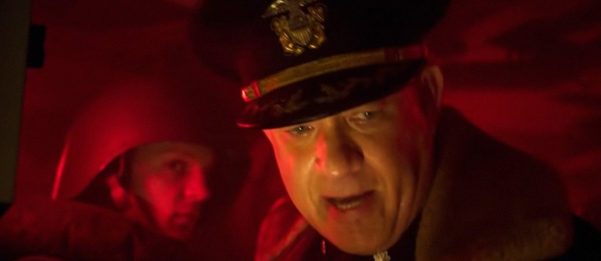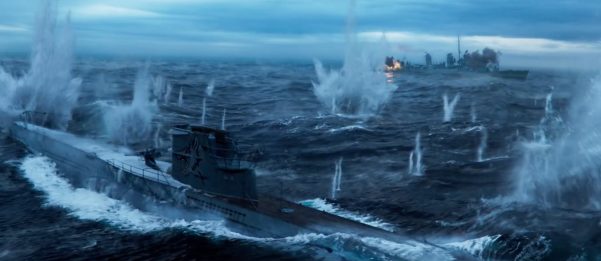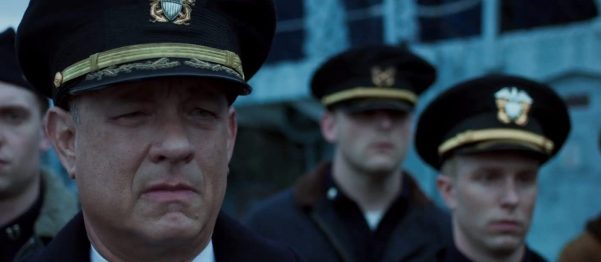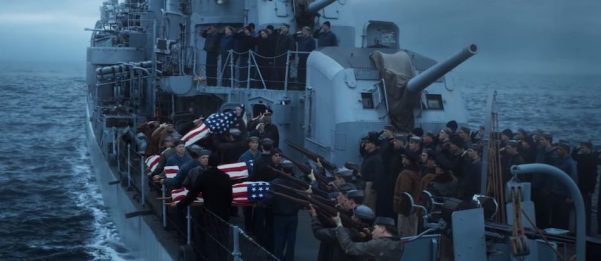Greyhound
10th July 2020
Early in World War 2, an inexperienced U.S. Navy captain must lead an Allied convoy being stalked by Nazi U-boat wolfpacks.
Aaron Schneider
Tom Hanks, Stephen Graham, Elisabeth Shue
12
1h 31m
The likes of 1917 and the newly released Greyhound show us that we’re currently living in a post-Dunkirk age for the war genre. In terms of the previously mentioned films, it’s not necessarily a criticism: both stand their ground as entertaining and visceral experiences, even if they’re ultimately overshadowed by Nolan’s masterful time-shifting war story. What makes them feel so influenced by Dunkirk is their tone, not their style. After all, 1917 went all-in and arguably overboard with its “one-shot” technique, and Greyhound feels deliberately old school with its basic chronological timeline.
What all 3 films have in common, however, is their focus on spectacle over character. The characters in each of these films don’t particularly represent individuals. They represent the soldier broadly. Again, this may sound like a criticism but certainly isn’t. The spectacle of each film is so well realised that it’s enough to hold everything in place, which is especially true for Dunkirk. The spectacle of Greyhound is within its sustained action/suspense scenes. For the majority of its tight 90-minute runtime, Greyhound does not take its foot off the pedal. Similar to thrillers like Speed or Phonebooth, the threat is present throughout and there is only time for the briefest of respites.
Greyhound tells a fictional story within The Battle of the Atlantic, a broad term used for all naval engagements in the Atlantic during WW2. In this particular instance, an inexperienced and religious Captain has the job of escorting a convoy of American ships full of soldiers and supplies to Britain, early in the war. The threat comes from a “wolfpack” of Nazi U-boats (submarines) which is hell-bent on sinking as many ships as possible before they reach the air cover zone near Britain. Whilst this specific mission and these specific boats did not exist, there were operations like this and Greyhound serves to condense the Atlantic campaign as a whole. It aims to demonstrate the kind of threat these boats faced on the dangerous crossing to Europe. Something it does very effectively.
As you may well imagine, Tom Hanks (Toy Story 4, Forrest Gump) is utterly convincing in the role of Captain Krause (despite the name, he is on the side of the Allies), injecting his usual assured “everyman” charisma to great effect. It really is effortless for him at this point, he knows exactly what he’s doing and is in complete control of his character. Simply superb.
Where the film flounders, however, is in the visual effects department, unfortunately. Extensive CGI is used to depict the ocean as well as the convoy of ships and submarines. To call the effects bad would be incorrect. Clearly great effort has gone into making this look as realistic as possible, but the human eye will always be able to spot this kind of fakery. Much of Greyhounds thrilling action scenes do then, unfortunately, resemble high-end videogame cutscenes. Some of this blame should fall with the director, who often chooses to shoot these warships from angles that a real camera would find impossible to achieve. It’s nowhere near as prevalent as in something like Justice League, but it’s noticeable nonetheless. These big sweeping effects shots clash with the more subtle and grounded work achieved on the bridge, where Tom Hanks gives orders to his crew. These scenes are frequently shifting from ship interior to exterior as Hanks uses his binoculars to spy incoming torpedos, and they are completely seamless. I believe Greyhound would be even better if it stuck to these less flashy effects.
Thankfully the pace and execution of the action are so well achieved that the visual effects are never a big distraction. You’re too busy being thrilled to particularly care, which is a big compliment. The script, which is also penned by Hanks, is full of convincing military jargon that’s never too difficult to decipher. But more importantly, Hanks sprinkles small but effective character moments. Moments like Captain Krause asking a messenger to retrieve slippers from his quarters, as you realise he’s spent the better part of 3 days stood up in his uncomfortable navy boots. A downside to the script is an unnecessary reliance on superimposed information. Dates, locations, distance from safety are all regularly shown in fade to blacks. It only serves to cut the tension, as we already know a day has passed because we’ve seen it go bloody dark! It’s an issue many war films have. Sometimes it’s needed, but titles are often used in an annoying abundance. Like in Greyhound.
These issues never detract too heavily from the picture as a whole, however, which works better as a compelling thriller over a traditional war film.
Greyhound is available to stream on Apple TV+ now
Breakneck pace
Hanks is great as always
Rousing score
Visual effects are largely unconvincing
Overreliance on superimposed information


























